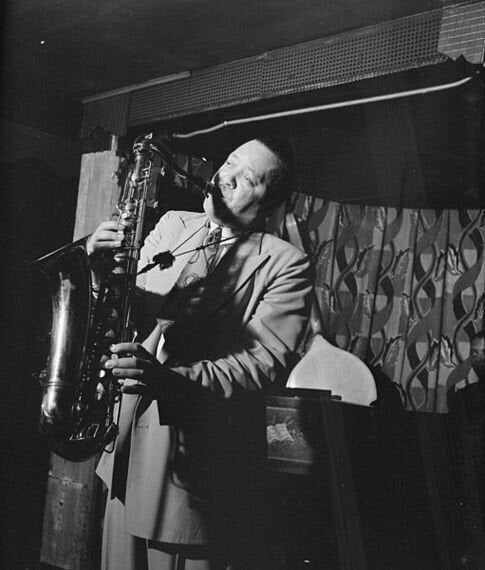She is cool.

Cara Delevigne, (c) Walterlan Papetti
He is not cool.

Louis Walsh, (c) Garry Knight
But what does cool even mean? Not "cool" as it refers to a person in vogue -- the latest X Factor sensation to be served up by Simon Cowell -- and neither as a way of describing a particularly stylish object or piece of clothing. But what it means to see someone, anyone, sitting by a bar... gazing mysteriously into darkness... and to think, "they're cool".
The birth of the cool
The modern usage of cool was created and disseminated by jazz saxophonist Lester Young in the 1940s. The star soloist of the Count Basie Orchestra -- "Lester Leaps In" (1939) -- and Billie Holiday's musical soul mate, Young developed a fast, floating aesthetic on the tenor saxophone as the avatar of "cool jazz". Appearing on screen in the short film Jammin' the Blues (1944), Young's signature style was equally iconic. At a time when black musicians were expected to conform to the high-energy histrionics of blackface minstrelsy, Young's idea of flash was to hold his horn sideways and up high with a stoical expression and languid pose... A legendary hip linguist who spoke in an impenetrable personal slang (see below), when Young first said "I'm cool" it translated as a strategic defiance of racism.
LESTER: "So, the little Esthereenie kittie was a good lick o'reenie for you, huh?"
JOHNNY OTIS: "Yeah, the little chick was a blessing for us. She's raisin' sand all over the country."
LESTER: "Y'all eatin' regular now... dig." [chuckle]
JOHNNY OTIS: "Yeah, and payin' the rent too, sometimes."
LESTER: "They'll be tryin' to copy her song, evonce -- that's the stuff you gotta' watch, dig."
[Johnny Otis, Upside Your Head! Rhythm and Blues on Central Avenue, 1993]
Ralph Ellison and Amiri Baraka both referred to the "bulletproof vest of cool" as a form of emotional self-control that contrasted against white racist violence. But "cool" for Young and for the African American musicians who followed him was not simply about keeping cool under fire -- an older turn of phrase. For a jazz musician, cool meant something more: a way of communicating emotion without losing control, of balancing sensitivity and restraint, of generating excitement without getting excited... Tough-looking jazz musicians like Lester Young and Miles Davis often held a strong Romantic ethos. As legendary jazzman Johnny Otis remembered: "In spite of what he went through, however, I don't hear hardship in Lester's playing. I hear a melancholy power and a lament, but I also hear a joyous celebration of life, the human spirit, and sexuality." [Upside Your Head! Rhythm and Blues on Central Avenue, 1993]
The most appropriate phrase for describing the aesthetic of cool coined by Young is, according to Joel Dinerstein -- who has been teaching, lecturing and publishing articles about "American cool" for more than a decade -- that of relaxed intensity...
In effect, the mask of cool represents a certain stylised suffering and compels wonder in an outside observer: Who is this person? What has she or he experienced?... It is a performance of emotional self-control that demands the suppression of a range of emotions. In its stylish stoicism there is a mix of hardness and vulnerability. Without the vulnerability it would be stone cold and unfeeling.
From Marlon Brando and James Dean to Patti Smith and Johnny Depp, the aesthetic of relaxed intensity has mediated the reception of many of the most iconically "cool" figures of popular culture.

Young at the Famous Door, New York, N.Y., c. September 1946. Photo by William P. Gottlieb
Physiologically cool?
The aesthetic of "cool" is of course deeply embedded in subjective notions of taste and style, but it is also a physical expression and an appearance, which -- like smiling or frowning -- most people can easily appreciate. Consequently, the whole aura behind the "cool" becomes more engaging upon consideration of what "relaxed intensity" might mean in physiological terms. And the answer has perhaps been supplied by the Institute of HeartMath, an internationally recognised research organisation.
The results of the Institute's research indicate that the brain is not the seat of all intelligence, but that it actually works in partnership with the heart:
Most of us have been taught in school that the heart is constantly responding to "orders" sent by the brain in the form of neural signals. However, it is not as commonly known that the heart actually sends more signals to the brain than the brain sends to the heart! Moreover, these heart signals have a significant effect on brain function - influencing emotional processing as well as higher cognitive faculties such as attention, perception, memory, and problem-solving. In other words, not only does the heart respond to the brain, but the brain continuously responds to the heart.
The heart in fact possesses its own intrinsic nervous system containing over 40,000 neurons -- a network so functionally sophisticated as to earn the description of a "heart brain". The heart is moreover also a hormonal gland, able to produce the well-known "love" or "bonding" hormone oxytocin, and acts as a key regulator of the emotional system. Consequently, different patterns of heart activity have distinct influences on cognitive and emotional function.
In effect, when the partnership between head and heart is working efficiently, we enter a specific and scientifically measurable state called psychophysiological coherence. It is both psychological and physiological because it is characterised by increased order in both our mental and bodily processes. It is, says the Institute of HeartMath, "a state of optimal function" -- and does not mean simply "relaxation":
At the physiological level, relaxation is characterized by an overall reduction in autonomic outflow... and a shift in ANS balance towards increased parasympathetic activity. Coherence is also associated with a relative increase in parasympathetic activity, thus encompassing a key element of the relaxation response, but is physiologically distinct from relaxation in that the system oscillates at its natural resonant frequency and there is increased harmony and synchronization in nervous system and heart-brain dynamics.
So what does all that half-relaxed coherence jargon actually feel like?
Psychologically, coherence is experienced as a calm, balanced, yet energized and responsive state that is conducive to everyday functioning and interaction, including the performance of tasks requiring mental acuity, focus, problem-solving, and decision-making, as well as physical activity and coordination.
"A calm, balanced, yet energized and responsive state"... Does that sound like relaxed intensity?
Coherence has been associated with enhanced emotional clarity, immune function, focus and creativity. What does it mean to say someone is cool? Perhaps we are simply commenting enviously on the outward signs of psychophysiological coherence.
**This article is an extended version of a post originally submitted by the author at mindthebollocks.co.uk**